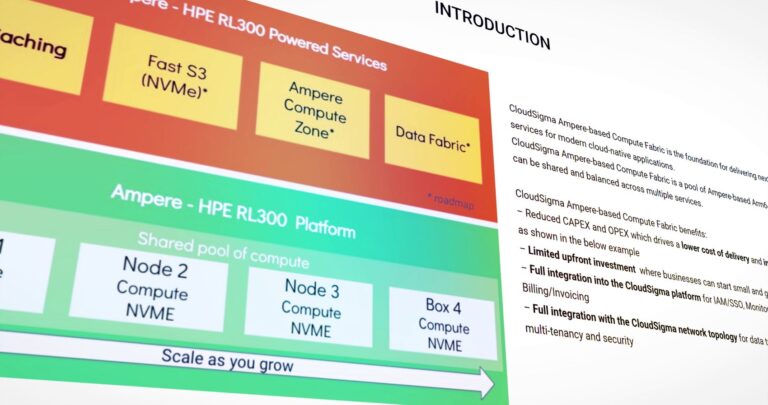Recently, audiences across the world tuned into the Eurovision Song Contest.
Attracting a global audience that typically reaches highs of 161 million, the contest’s technical preparation team were feeling the pressure to perform as well the artists.
Shows like these, and how they are delivered, need to surpass all expectations, connecting audiences and delivering stable viewing experiences no matter the medium or location viewers choose to watch with and from. This means the spotlight is firmly on how the extensive demand for consumer experiences is managed – which means data, lots of data.
In the event that viewers stream the entirety of a show, like Eurovision, across their mobile devices, more than 1.9m TB of data – or the in-stadium data consumption of approximately 23,000 Super Bowls – would be used.
Balancing high demand for data and delivering a consistent connected experience ultimately requires the deployment of multiple clouds, all working in harmony, with applications and workloads stored, moved and managed, across them all, all the way through to the device.
So how does this approach improve the way we view and experience the Eurovision song contest?
- Ensuring an engaging multimedia experience for all: No fan wants to feel as though they’ve missed the witty TV soundbite that’s trending on Twitter or the live replay of a backstage interview that throws voting intentions in doubt.In combining different cloud environments, private, public and edge clouds, these fears can be allayed. With a local public network, producers can enable those in the arena to access and download mobile apps, share content in real-time and re-watch highlights. While, thanks to edge environments, where data is processed closer to the device, viewers could be on the other side of the world, reacting and celebrating together with those in the arena, and still listen to commentary or read social posts.
This immersive experience falls down if the streaming quality is not consistent and produces buffering, pixelation or downtime. It’s here that a multi-cloud environment caters for a range of devices with different bandwidths through software defined network awareness.
- Drones and remote streaming: Fans expect roving drone footage, unique shots and real-time broadcast. For the spectacle to be captured in such comprehension, it requires robust and reliable connectivity, instant access to data storage and retrieval, as well as vast AI to best analyse a multiplicity of input.
With the speed, low-latency and reliability of edge environments, remote-controlled drones can produce state-of-the-art content, capturing exciting shots and video in real-time. Then, in unison with public and telco networks, securely store whilst simultaneously uploading the feeds to mobile apps, and even beam it instantly to remote devices such as terminals in the venue for live content editing, solving a major challenge producers have faced for decades.
- ’A single pane of glass’ network view: With any large event, it’s not uncommon to have hundreds of contractors, from sound and lighting engineers to health and safety teams.
Each contractor needs to be in the right place, at the right time, to communicate, and have visibility into the stages of various projects – whether that’s stage construction or lighting effects. This generates a challenge for the event production and management given each party likely uses its own digital infrastructure. While private clouds keep sensitive information safe, each contractor would also need to connect to public networks to scale applications and collaborate on documents, like work and safety sheets. A multi-cloud approach enables seamless logistics and planning and offers a ‘single pane of glass’ network view to boost data use where it is needed and federate seamlessly through software defined networking.
- Capturing creative moments: Each year, the creativity of Eurovision reaches new levels, driven by the potential of technology.
In bringing together public and edge clouds, performances can be choreographed to ensure each camera will be in the right place at the right time and that specific drone routines and camera shots will be available to mobile viewers. The edge cloud can capture creative moments as-they-happen, which are then scaled quickly and stored with public networks. Then, only in conjunction with telco networks and infrastructure, they can be streamed in real-time straight to user devices, including data overlay and deep-information.
- Physical and digital security: The security of fans, staff and performers is paramount – both physical security and protecting the integrity of the content online. Fans want to be reassured that the content they are engaging with is legitimate, voting is safe, and their personal information is stored securely. Similarly, organisers must be sure that each drone has a robust network that cannot be tampered with.
Smarter security is critical to this, where the context of consumption and integration is visible, and AI can involve itself at scale to ensure behaviour of the networks and data is as expected. With different clouds working together, producers must take advantage of the intrinsically comprehensive, software approach to security – ensuring scalability and the flexibility to understand each device and data use-case.
As major events from sport to entertainment return to the world “in person,” we continue to see the rapid evolution of consumers, new expectations demanded by fans and innovations for a rich, companion-based media world.
However, to realise these end results traditional IT is not a feasible approach. A smart multi-cloud strategy is critical. With different clouds working in unison, organisers can future proof events and deliver consistent viewing experiences. The robust nature of multi-cloud helps events, like Eurovision, maintain the delights of the performances all while balancing exponential demands for data and security.
About the Author
Richard Bennett is Head of Industry Solutions & Strategy, EMEA at VMware. VMware is a leading provider of multi-cloud services for all apps, enabling digital innovation with enterprise control. At the heart of everything we do lies the responsibility and the opportunity to build a sustainable, equitable and more secure future for all.
Featured image: ©freshidea


